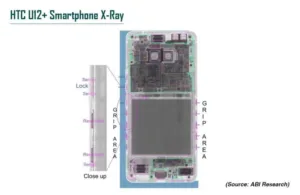HTC introduced the next wave of smartphone user-interface innovation with the debut of Edge Sense on its U11.
The recently released HTC U12+ features the next-generation Edge Sense 2, which reportedly brings even more ways to interact with the phone — simply by squeezing its lower sides or edges. While the technology behind the squeeze is impressive from a technical point of view, the Edge Sense 2 does not deliver a positive user experience (UX), announced the Teardowns service of ABI Research, a market foresight advisory firm providing strategic guidance on the most compelling transformative technologies.
However, it is how HTC embedded the Edge Sense 2 technology that impressed the Teardowns team, stated Jim Mielke, Vice President of Teardowns at ABI Research. HTC has embedded 10 ultrasonic sensors and nine ceramic resonators into the sides of the smartphone. The ceramic resonators create the ultrasonic wave throughout the smartphone, which is then received by one of Sentons’ ultrasonic sensors under the buttons or grip area. “Although we have seen a few attempts of bringing vibration technology into smartphones, we have not seen a compelling experience to make the technology a mainstay,” said Mielke. Acoustical ceramic resonator vibration has been attempted to replace the smartphone’s speakers but has suffered from poor audio. Ultrasonic ceramic vibration is used for fingerprint identification, but it is a minor player compared to capacitive sensing techniques. HTC is now on the forefront of ultrasonic ceramic vibration for grip sensing.
While the ultrasonic ceramic vibration technology may be impressive, the UX needs improvement. Whether to take photographs or open an application, there is a learning curve to use the squeeze function for the desired result. “The user receives no feedback as to how soft or hard to squeeze for the intended response,” said Mielke. “The Edge Sense 2 activation indicators will cause frustration. These issues could be overcome with software updates, and as the technology evolves, it could find some very interesting applications,” Mielke concluded.
ABI Research’s Teardowns team uncovers innovative design features and new semiconductor components to guide enterprises toward more streamlined solutions in future designs or to provide complete competitive analysis. We provide clients with ultra-high resolution images, functional block diagrams, pinpoint power measurements, and detailed cost analysis in BOM (bill of materials) and parts lists for phones, connected devices, smart home devices, wearables and components.
About ABI Research
ABI Research provides strategic guidance for visionaries needing market foresight on the most compelling transformative technologies, which reshape workforces, identify holes in a market, create new business models and drive new revenue streams. ABI’s own research visionaries take stances early on those technologies, publishing groundbreaking studies often years ahead of other technology advisory firms. ABI analysts deliver their conclusions and recommendations in easily and quickly absorbed formats to ensure proper context. Our analysts strategically guide visionaries to take action now and inspire their business to realize a bigger picture. For more information about ABI Research’s forecasting, consulting and teardown services, visionaries can contact us at +1.516.624.2500 in the Americas, +44.203.326.0140 in Europe, +65.6592.0290 in Asia-Pacific or visit www.abiresearch.com.

